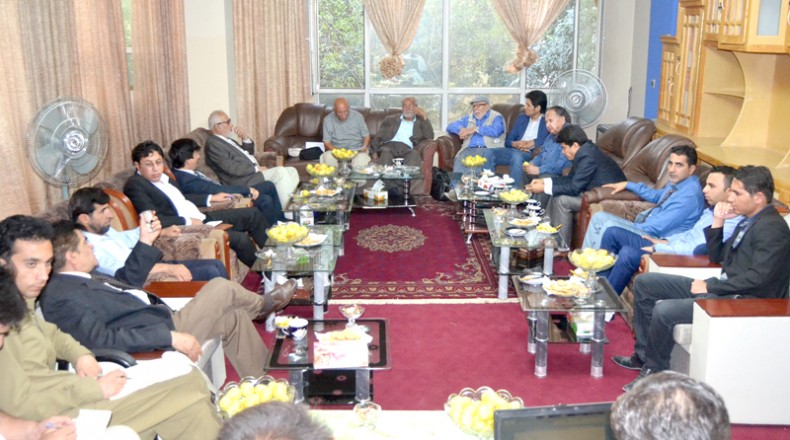5 million citizens educated since 2002 including 60 percent females; seven million citizens still illiterate; 78 ‘adult literacy schools’ functional across country
The Ministry of Education says it has annually covered an average of 500,000 people with literacy programs. Currently around 796,000 people, aged over 15, are attending around 31,840 courses.
Literacy Program Director, Mr. Jam holds poverty, insecurity, social restraints and taboo, lack of awareness about importance of literacy for women, and early marriages are some of the serious impediments that are responsible for illiteracy among women
The reasons are; poverty, insecurity, social taboos, unawareness of families about importance of literacy for women, early marriages, and in general our society is not mentally prepared to accept this reality to send their daughters to schools and this practice is affecting girl education in the country, particular in rural areas.
By Baber Khan Sahel
KABUL: Literacy Department of the Ministry of Education (MoE) says around five million Afghans have been educated through literacy courses and programs over the past 12 years, but seven million people still are illiterate.
In general 60 percent of the covered persons are females as part of the drive to minimize the large gap between male and female literacy rate.
Literacy programs are now a national priority for Afghan nation as over the past three decades of war, millions of Afghans were deprived of basic education. According to MoE, 12 years ago at least 12 million Afghans were illiterate, but the figure has come down to seven million in 2014. The ministry has been abled over the past one decade to annually cover an average of 500,000 people with literacy programs. Currently around 796,000 people, aged over 15, are attending around 31,840 courses along with 78 Adult Literacy Schools (ALSc) organized by the department in different parts of the country.
Currently around 36 percent countrymen are educated while the national average for literacy stands at 20 percent for women as compared to 50 percent for men. As we move away from the main cities, particularly Kabul, Balkh, and Herat followed by Badakhshan, and into rural areas, in some provinces only one percent of women were found to be literate, according to MoE data.
MoE says it has planned to increase national literacy rate from 36% (20% female, 50% male) in 2013 to 59% (51% female and 66% male) by 2020 across all groups of men and women aged 15 and above, targeting females, language minority groups, isolated communities, Kuchis and people with disabilities. By end of the 2014 the national literacy average rate will jump from current 36% (20% female, 50% male) to 38 % (23% female, 52).
To provide more information on literacy programs in the country, Afghanistan Times conducted an informative interview with Allahbaz Jam, Literacy Program Director of the Literacy Department of the MoE.
AT: Which group of the society is more deprived of education or illiterate?
Jam: A big part of the illiterates are constituted by elders, aged over 20 with an increased women percentage it mean women make a big part of the illiterate persons. In general illiteracy rate is high among women comparing to men because of some specific reasons.
AT: What are the reasons behind women illiteracy?
Jam: The reasons are; poverty, insecurity, social taboos, unawareness of families about importance of literacy for women, early marriages, and in general our society is not mentally prepared to accept this reality to send their daughters to schools and this practice is affecting girl education in the country, particular in rural areas.
AT: Literacy programs are part of the key government strategies or not?
Jam: According to articles 43, 44, 45, 46 of the Afghan constitution, the government is responsible to provide free and equal education to all Afghans, equally to men and women. So as per the constitution, the government in last one decade succeeded to annually cover at least 500,000 people through literacy programs throughout the country without any discrimination.
AT: Tell us about effectiveness of literacy programs in 2014 as the year is full of political, economic challenges and disputes?
Jam: This year we have planned to implement at least 32,000 literacy courses in different parts of the country. Through these courses around 800,000 people would be covered with special literacy programs. At least 60 percent of the participants in the courses are women.
AT: What organizations are supporting the Afghan government when we talk of literacy drives in the country?
Jam: The programs are technically and financially supported by Afghan government and international community, donors and NGOs. The cooperative organizations are the United Nations Educational Scientific and Cultural Organization (UNESCO), United Nation International Children Emergency Fund (UNICEF), United Nations World Food Program (UNWFP), Japan International Cooperation Agency (JICA) and a number of other partner agencies.
AT: Who, and which places are your main targets to be covered with literacy programs?
Jam: Our major literacy programs are being implemented in the society, rural areas and cities for the public as well as we have cooperative role with governmental organs. We have been working with the Ministry of Interior (MoI) on Literacy Enhancement for Afghanistan Police or (LEAP), Ministry of Defense (MoD), Ministry of Women Affairs (MoWA), Ministry of Labors and Social Affairs (MoLSA) and other government bodies; if there is need for literacy programs to be launched for the illiterate employees. Normally we annually cover 50,000 persons in each mentioned ministry.
AT: Are there any literacy program for prisoners?
Jam: Yes, we have. We have been trying to launch literacy programs for inmates nearly in all prisons because most of the prisoners are uneducated persons and they are unaware of their rights and laws to decide about their life and their future. As well as we planned a number of vocational trainings for the prisoners to learn skills and after release they could drive the livelihood in a better manner.
AT: Has the department been able to cover insecure areas?
Jam: In order to cover illiterate people in insecure areas we designed a special program in 2008 with full cooperation of local religious scholars and tribal elders. The program proved effective. We were using the local human force and there was no need for additional facilities to cost more, as chairs, desks, blackboards and classes of the schools were used in this program.
AT: As you know Kuchis (nomads) constitute a big percentage of the society according to an official estimation there are 2.4 million Kuchis of whom only 6% can read and write. Tell us about programs designed to educate them?
Jam: Kuchis have been the more deprived group of the society with a highest percentage of illiteracy. It is difficult for them to attend formal education system in schools, because they have no permanent residence and over the year they move from place to place i.e. warm-climate areas in winter to cold-climate zones in summer time. The ministry of education drafted a practical literacy program for Kuchis in 2011 and was implemented in 2012, 2013 and is underway this year as well.
AT: Have you seen illiterate people who don’t want to attend your programs?
Jam: Yes, some people don’t know about importance of the programs and to encourage them we have special programs. Public awareness campaigns are parts of our mission to aware people about importance of education and literacy. Each year the ministry in close cooperation with its international partners marks International Day of Literacy on September 8. After that the ministry continues the public awareness campaign for nearly one month. We want public to help us to expand and make effective our literacy programs. They can evaluate our programs and they can prevent opportunists from misusing this process.
AT: Was there any new literacy program drafted for next year?
Jam: A new program is underway to be designed for extending our programs through schools while using teachers as human force in our programs. As per the new plan, school teachers would be hired and given less amount as salary to teach illiterate persons in their areas. School facilities would be used for this program—free of cost. We hope this program will cover more people in different areas.
AT: Do the partner organizations and NGOs coordinate their programs with literacy department?
Jam: Yes. We have monthly coordinative meetings with all stakeholders to discuss the achievements and hurdles before the programs are launched. We discuss ways to deal with the challenges and tame illiteracy.
AT: Have you exact statistics on literacy rate?
Jam: To find out real statistics of literacy, level of education, access to schools and other education related statistics, we planned to design and launch a nationwide survey. The survey will determine the real and reliable statistics for our future plans. The survey will find exact number of the educated and illiterate persons, also main challenges and hurdles before the education sector of the country.
AT: Tell us about financial problems that the department is facing now?
Jam: In the part of financial resources, we have planned to design our programs and activities in such a way to find out our own financial resources in the country. In case, if the international community cuts its funds off then we should have alternatives to continue our programs. We need to continue this national program for long term.
AT: Have you paved the ground for the participants to continue study or join formal education system, if they want?
Jam: The persons who complete our six and nine-months-long courses are awarded a certificate which is equally certified as certificate of fourth grade. So if these persons wanted to continue their study, they can directly take admission in fourth grade in schools. As you know our participants are people, aged from 15 to 45, and they can’t attend common schools, therefore we have inaugurated and opened Adult-Literacy Schools for them in capital and provinces. We have 65 ALSc that follow same education curriculum as that of formal education system. Adult schools also give admission to those who quit their studies before to complete high schools or to complete 12th grade. In general we try to at least enable the illiterate people to read, write and count in their daily life and activities.
AT: Share something with us about skill-based literacy programs?
Jam: Our second mission is skills-based trainings in order to provide vocational trainings for the participants, because most of the participants have left their studies because of poverty and they want to work in job market, so by providing literacy and vocational trainings at same time, we can make them literate as well as skilled and professional workers to compete in job market.
AT: What are the main challenges that keep Afghans away from education?
Jam: Conflicts, insecurity, lack of access to education facilities, poverty, joblessness, unawareness of the people from importance of the education and obsolete social customs are main reasons that are depriving Afghans from the charm of education.
Lack of access to technical and financial resources is another major problem before our department. A big percentage of the countrymen are illiterate and there is need for enough financial and technical resources and facilities to provide most of these countrymen at least with literacy programs.
 Afghanistan Times
Afghanistan Times




